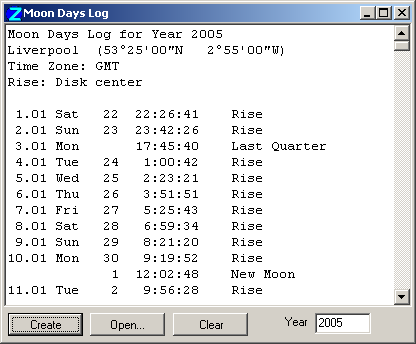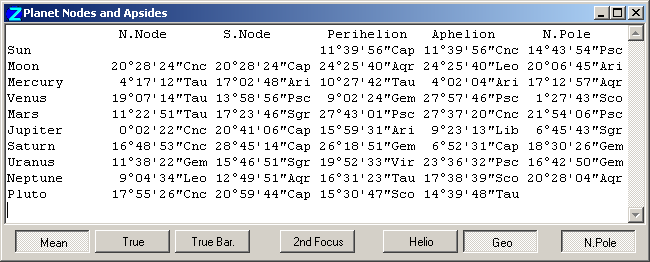Astrological Tables
Selecting "Tables" from the main menu or clicking
the  "Tables"
Toolbar button, and selecting "Astrological Tables",
displays the following submenu:
"Tables"
Toolbar button, and selecting "Astrological Tables",
displays the following submenu:
Mundane Aspects of the Moon
The Mundane Aspects of the Moon window lists aspects and ingresses of the Moon for the calendar month indicated by the entryfields at the top of the window.
The data is required for calculating the periods in which the Moon is 'void-of-course', i.e. when it does not make any major aspects before ingress into the next sign of the Zodiac. In horary astrology, such periods are considered times when it is possible to answer the asked question by "from this nothing will turn out".
For example, if now on June 25th, 2005, 15:18 the Moon is still not void of course, this period will begin at 18:22 and will end on the 26th at 6:03.
The period of the Void Moon depends on whether the traditional septener or the complement of 10 planets is used. For example, by septener the Moon is void-of-course, because the last aspect before ingress into Pisces was the trine to Jupiter on June 24th. For (de/)selecting septener, use the checkbox Septener only at the top of the window.
To create the table for a paricular month, set the month and year at the top of the window, and press the "Calculate" button at top-left. The result is saved in the file [ZET]\MoonAsp\yyyy_mm.dat (where yyyy and mm are the year and month of calculation respectively). If a data file exists for the month and year entered, it is loaded automatically into the window, and calculation is not performed. (You should understand the implications for void-of-course calculations of settings on the Chart Settings - Wheel topic).
Moon Days Log
Selecting this option displays the Moon Days Log window of Moon rises and phases:

Terminology: the day of the Lunar month (Lunar day, Moon day, or Day of the Moon) commences with the Rising of the Moon, or the instant of New Moon; and ends at the next Rising of the Moon, or the following New Moon (whichever comes first). The first and last Moon Days can thus be very short. The lunar month can contain 29 or 30 Lunar days.
The calculation of the Moon Days Log is essentially dependent on the geographical position of the observer.
Moon Apogees and Perigees
The Moon Apogees and Perigees window is similar to the Moon Day Log window, except that its operation creates and displays a log file MapXXXX.wrk of the times in the calendar Year XXXX when the Moon is in apogee (maximum distance from the Earth) or in perigee (minimum distance from the Earth) during revolutions of its orbit.
The point of last apogee of the Moon prior to the current date is called the Astral Black Moon. Abnormally close points of perigee are considered significant in horary astrology.
Planet Nodes and Apsides
Selecting this option displays the Planet Nodes and Apsides window:

The window lists some of the orbital elements of the main planets, i.e. the parameters and their values used to establish celestial body's orbit in position, shape and size, and the position of the body in its orbit at a given time. The data displayed is for the current event time. The buttons at bottom of the window select some display variants of the data, as follows:
Sunrise and Sunset
The Sunrise and Sunset window is similar to the Moon Day Log window, except that its operation creates and displays a log file SunXXXX.wrk of the times of sunrises and sunsets for the calendar Year XXXX, together with durations of daytime (Dhour column) and night magic hours (Nhour column). The following table lists the planet-rulers of these magic hours:
| Day | Sun | Fri | Wed | Mon | Sat | Thu | Tue | Night |
| Sun | 1 | - | - | 12 | 11 | 10 | 9 | Jupiter |
| Venus | 2 | 1 | - | - | 12 | 11 | 10 | Mars |
| Mercury | 3 | 2 | 1 | - | - | 12 | 11 | Sun |
| Moon | 4 | 3 | 2 | 1 | - | - | 12 | Venus |
| Saturn | 5 | 4 | 3 | 2 | 1 | - | - | Mercury |
| Jupiter | 6 | 5 | 4 | 3 | 2 | 1 | - | Moon |
| Mars | 7 | 6 | 5 | 4 | 3 | 2 | 1 | Saturn |
| Venus | 9 | 8 | 7 | 6 | 5 | 4 | 3 | Mars |
| Mercury | 10 | 9 | 8 | 7 | 6 | 5 | 4 | Sun |
| Moon | 11 | 10 | 9 | 8 | 7 | 6 | 5 | Venus |
| Saturn | 12 | 11 | 10 | 9 | 8 | 7 | 6 | Mercury |
| Jupiter | - | 12 | 11 | 10 | 9 | 8 | 7 | Moon |
| Mars | - | - | 12 | 11 | 10 | 9 | 8 | Saturn |
Ingress of Planet
Selecting this menu option presents a further submenu listing the planets Moon thru Pluto. Selecting a planet (say, Uranus) displays a window similar to the Moon Day Log window, except that its operation creates and displays a log file with the name, say IngresUranus1900_150.txt of dates and times when the selected planet enters a new Zodiac sign during the period specified (in this case 150 years).
Use the Period entryfield to set the range of calendar years for calculation, and the Begin entryfield to set the starting year.
When the Retro button is checked, the log also includes dates and times when the planet is 'on station', and an indication of its subsequent retrograde and direct motion.
When the Decl button is checked, the log file contains declination movement information, rather than longitude movement data, i.e. specifically dates and times when the planet crosses the ecliptic. If the Retro button is also checked with this option, the log includes dates and times of maximum and minimum declination.
Here is part of the above-mentioned log of Ingresses of Planet Uranus:
Time Zone: +00:00 System: Ecliptic Geocentric Ingressions of planet Uranus for 1900 - 2049 year 3.06.2002 0:10 R 28°50' 8"Aqr 4.11.2002 6:27 D 24°54'30"Aqr 10.03.2003 20:54 > Psc 7.06.2003 6:59 R 2°49'14"Psc 15.09.2003 3:46 > Aqr 8.11.2003 12:43 D 28°53'42"Aqr 30.12.2003 9:07 > Psc 10.06.2004 15:48 R 6°47'46"Psc 11.11.2004 19:12 D 2°52'20"Psc
The Retro option was ON, and the Decl option was OFF when creating this log.